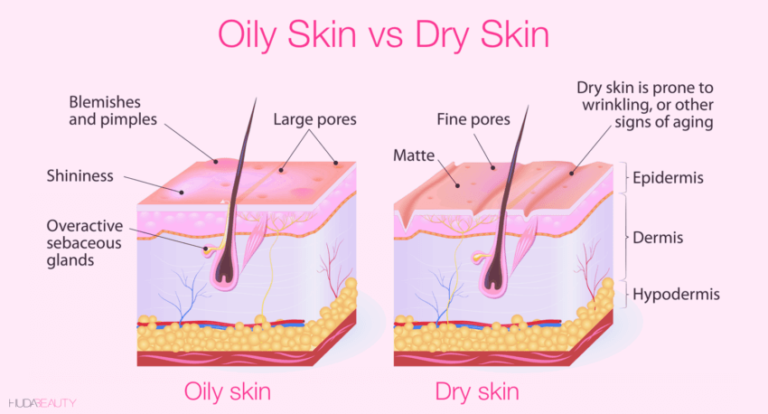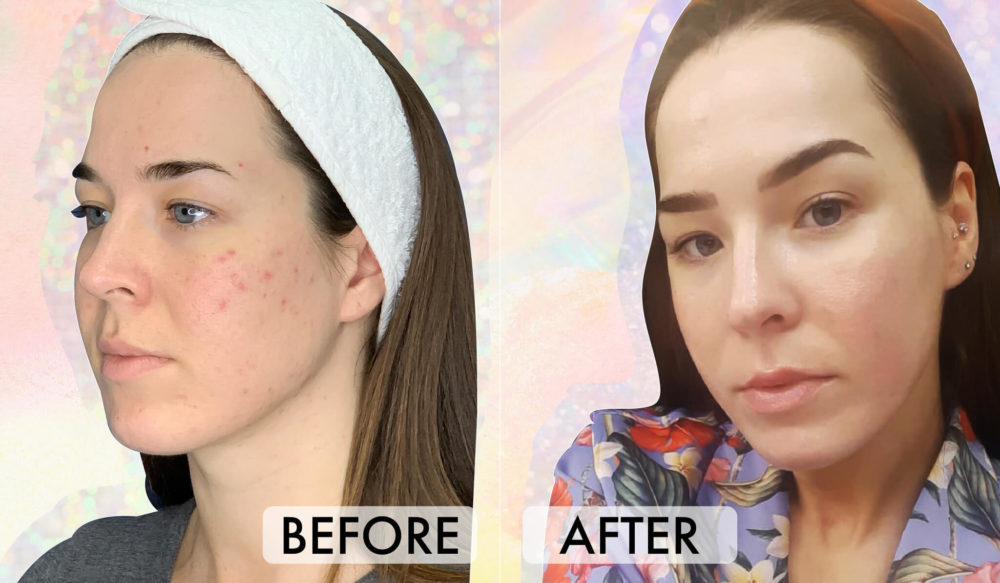The Number 1 Skincare Rule Everyone Should Know

We’ll get straight to it: knowing and understanding your skin type is the cornerstone to healthy, glowing skin. Seriously, trying to curate a skincare regimen without knowing this key fact could actually end up harming, instead of helping your glow game. Identifying your skin type may sound easy, but it’s one of the most common skincare mistakes people make.
If you’re not sure of your skin type and use the wrong products, it can compromise your skin’s natural balance and result in skin sensitivity, breakouts, irritation, inflammation, and even premature aging. It’s also important to understand that your skin is hereditary, so although you can’t change it, you can keep it balanced with the right routine that targets your skin concerns.
It’s also important to note that as your hormones change through your teen years into adulthood and beyond, your skin will change. Similarly, your environment, climate, and seasonal changes will also cause your skin’s needs to change. So basically, get to know your skin so you can recognize any changes and adjust your routine accordingly.
To help you get up close and personal with your skin type, we’ve broken down the most common skin types – oily, dry, combo, neutral, sensitive, and mature – and some tips for looking after each.
Oily Skin

What oily skin looks like: If you have oily skin, it’s often visibly shiny with larger pores – the pores look larger as they contain excess sebum created by your sebaceous glands. The level of shine will typically increase throughout the day. You’ll also be more prone to inflammatory acne; pustules and pimples, as well as non-inflammatory acne, like blackheads and whiteheads. Oily skin can also be prompted by any form of hormone change, like your period or pregnancy.
While oily skin has some irritating qualities, like midday shine and clogged pores, the upside is that people with oily skin tend to have fewer wrinkles as they age due to all that extra sebum moisturizing your skin.
Why it’s oily: While everyone has pores – or what medical experts refer to as sebaceous glands – some of us deal with glands that are naturally just larger and/or more active. “Sebaceous glands are important because they secrete sebum to lubricate the skin. They form during gestation, shrink after birth, and then enlarge again in puberty,” explains Dr. Tahl Humes, medical director and founder of Vitahl Medical Aesthetics in Chicago and Denver.
Dr. Humes adds, “We cannot change our genetics, but we can use quality skincare products to keep [oily skin] under control.” It’s best to wash your face twice a day with a gentle cleanser – foaming or gel are some of the best products for oily skin types – and then follow up with a mattifying toner and lightweight gel moisturizer to keep skin balanced. Don’t forget SPF, either. Check out our derm-approved routine for oily skin here.
Top Tip: Just because your skin is oily, doesn’t mean it has an abundance of moisture. Add hydrating serums and moisturizers to your routine to keep skin hydration levels in check, because dehydrated skin tends to create extra oil to compensate for a lack of moisture.
Finally, washing your face more often will not make your skin less oily. In fact, using harsh cleansers too often will strip moisture from your skin and may cause your skin to produce even more oil. Use a gentle cleanser in the morning and double cleanse at night. Check out our guide to finding the perfect cleanser for you here.

Dry Skin
What dry skin looks like: Dry skin is often dull, especially around the eyes, accentuating fine lines and wrinkles. If your skin is dry, your pores will most likely be small and barely visible (lucky you!). Your skin might feel tight and rough; it may even chap. Although, if your skin is extremely flakey, your skin may be prone to skin conditions like eczema or dermatitis.
Why your skin is dry: Dry skin is caused by a lack of moisture in the corneous layer, which also makes your pores less visible due to the lack of sebum. The lack of moisture also means that your skin loses its natural elasticity, which is why it can feel tight.
There’s also a huge difference between dry and dehydrated skin. NYC dermatologist, Dr. Day explains that “dry skin is related to the outermost layer of the skin, namely the stratum corneum,” whereas “dehydrated skin is skin that has had excess water loss due to both internal and external factors.” She continues to explain that “You can drink all the water there is and still have dry skin.”
View this post on Instagram
Top Tips: Celeb dermatologist, Dr. Colbert, who’s responsible for Sienna Miller and Naomi Watts’ radiant skin, says “you mustn’t over wash dry skin because it upsets the natural skin barrier that holds in moisture and protects the delicate equilibrium between dry and oily.” Check out these cleansers we love for dry and thirsty skin.
Dr. Dennis Gross, Founder of the Dr. Dennis Gross skincare line recommends to “Avoid alcohol-based toners and look for products that include hydrating ingredients like hyaluronic acid.” Be sure to always lock in your hydrating serums with a rich formula. We love the Embryolisse Filaderme Emulsion, $22, as it’s packed with mega-hydrators, like shea butter, aloe vera, and squalene, which give an omega-rich surge of hydration that’ll boost levels of elasticity in the skin.
Sidenote: Dehydrated skin! Dehydrated skin is usually down to a combo of internal and external factors, it could be that you’re not drinking enough water – you should aim for at least two liters a day – however, you can still have dehydrated skin while your body is hydrated. Too much salty food, sugar, alcohol, and drinking too much caffeine are the most common contributors to dehydrated skin. External factors like “excess sun exposure and excess hot yoga, which essentially cook the water out of your skin,” will also cause skin dehydration.
Acne-Prone Skin

What acne-prone skin looks like: Skin prone to breakouts is typically oily, and often has blackheads and whiteheads as well as pustules, pimples, and papules in concentrated patches.
Why it’s acne prone: The most common type of acne occurs when the opening of a hair follicle is blocked with a combination of dead skin cells and sebum (the natural oil your skin produces). This then causes whiteheads, blackheads, and pimples to form. This can develop into cystic acne.
When people refer to ‘hormonal acne’ this is in fact, a variant of regular acne. It’s not a term used by medical professionals, it’s simply named hormonal acne as the increase in oil production that blocks the hair follicle is a result of hormonal changes, which is why you experience an influx of pimples when there are certain types of hormones circulating your body. There are other forms of acne including fungal acne and acne rosacea. Check out our guide to decoding your acne-prone skin here for more deets.
One huge acne myth we have to debunk: “It is a huge misconception that acne is a skin problem that affects teenagers,” says Dr. Corey L. Hartman, a board-certified dermatologist and founder of Skin Wellness Dermatology in Birmingham. “In reality, I see so many adults looking to clear their skin of acne. Hormones and our skin’s oil production changes throughout our lives, especially in women who battle with acne related to [their menstrual cycle and] pregnancy.”
Top Tip: Trust us when we say that when a breakout hits, we know that your natural instinct is to dive in with allll the products, or worse, to squeeze your pimple. The trick is: less is more. Squeezing will most likely result in damage to your skin, a slower healing process, and post-pimple marks. The best options is to continue with your usual routine (check out this routine for acne-prone skin here) and apply a gentle yet effective spot treatment, like the Inkey List Succinic Acid Blemish Treatment, $10, which helps shrink pimples without drying out the skin.
Combination Skin

What combination skin looks like: Combination skin is super common and consists of two contrasting skin types, usually oily and dry. The skin on your T-zone (forehead and nose) will typically be oily, resulting in larger pores, while your cheeks and other areas might feel dry.
Top tip: We know it sounds extra AF, but it’ll help if you use different products to target different areas of your skin. Concentrate your clay mask on your T-zone only and avoid using heavy creams on your T-zone.
Try a hydrating skincare routine that will balance oily skin and add moisture to dry areas.
Neutral Skin
PSA: we’re trading in the commonly used term “normal skin” for neutral skin, because let’s be real, there is no such thing as ‘normal’ skin. However, skin that is neutral implies it is somewhere in the middle, neither oily nor dry.
What neutral skin looks like: If you have neutral skin, you’re likely to have some pores, the occasional blemish, little dryness, and no issues with excess oil.
Top Tip: If you have neutral skin, you might feel that you don’t need to do too much to your skin, which means you could have a more paired back skincare routine. This is totally fine, but it doesn’t mean you should neglect the skincare basics. Always double cleanse your skin at night to make sure you’re washing off the dirt, pollution and makeup of the day, then follow with a hydrating serum and moisturizer. For the glowiest skin, don’t forget to exfoliate two to three times a week, and add in a facial oil for super nourished, glowing skin. Finally, sunscreen is ALWAYS a must! Check out how to layer your skincare routine here.
Sensitive Skin

It’s hard to diagnose sensitive skin as it’s not always visibly red or itchy and medical experts define it more as skin that is reactive. This means things like hormones, a new product or other external factors like pollution, food, sweat or even heat can trigger the skin to feel sensitized.
What sensitive skin looks like: Some common signs of sensitized skin include redness, blotchiness, dryness, or itchiness. Those with sensitive skin might also be more likely to experience inflammatory skin conditions like eczema or rosacea. One clear indication that you have sensitive skin is that using new skincare products cause stinging or tingling when you first apply them.
Why it’s sensitive: Sensitive skin can be triggered by a whole variety of things that cause the nerve endings in the top layer of the skin to become irritated. The nerve endings are super sensitive as your skin’s natural barrier is fragile, which makes it easily affected by external factors. These factors could be anything from cold weather to hot water, stress, hormonal changes or a lack of sleep. This is why it’s so important to treat your skin with the right topical nourishing creams.
Top Tip: Steer clear of harsh ingredients like glycolic acid, salicylic acid, and retinol and instead opt for soothing products with ingredients like niacinamide, ceramides, colloidal oatmeal, rosehip oil, and hydrating glycerin. As your skin’s natural defense layer may be weaker, it also means that your skin loses moisture more rapidly, so you should pay extra attention to hydrating and nourishing your skin.
Mature Skin
What mature skin looks like: Dr. Timm Golueke, leading dermatologist and founder of the Dr. Golüke clinic in Munich, explains that as we age, our skin stops producing collagen and hyaluronic acid, while the “the sebaceous glands produce fewer lipids and skin becomes drier.” The skin is also more prone to sagging, especially around the eyes and neck due to a loss of moisture and elasticity. Aging skin is also prone to dark pigmented spots resulting from sun damage.
Top Tip: Get on the retinol train, it’s the derm favorite for improving skin cell turnover, and one of the few topical ingredients that can really help to improve the appearance of fine lines, wrinkles, and hyperpigmentation, thanks to its collagen boosting powers. Get the full scoop on retinoids and how to use one in your routine here.
Still Not Sure of Your Skin Type?
Try this skin test: Wash your face thoroughly with warm water, cleanse and then pat dry with a towel. Leave your skin to sit fresh and clean for 30 minutes, get the mirror and examine your skin: are your pores visible or not? Do you have spots or whiteheads? Can you see any flaking? Access your skin, and see how it compares with the above categories. Repeat this test every six months, as your skin is always changing, responding to internal factors like your hormones, age or diet, plus external factors like the weather.
Now you know your skin type (and remember, it can fluctuate), there’s no reason why you can’t cater all of your products to your skin’s specific needs. So, check out our guides to make sure you’re using the right moisturizer, cleanser, and toner for your skin type.
For more skincare tips, check out how to curate a skincare routine like a pro.
Disclaimer: Every product we review has been independently selected and tested without bias by our editorial team. We never take payment to review products, although some brands allow affiliate links, so we may earn a commission if you purchase a product by clicking on one of our links.























Leave a comment